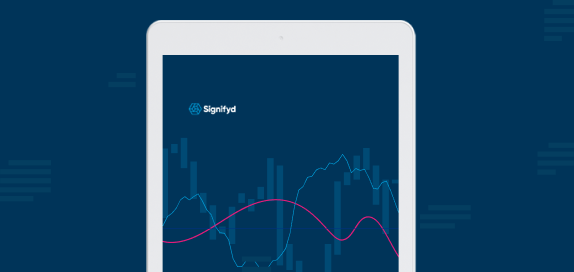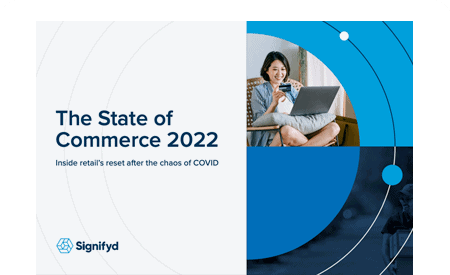Ecommerce sales in September seem to prove that despite the pressures of the economy, two constants remain: We still care about looking good and we will no longer give up our holidays.
Next up? Halloween.
Ecommerce had a solid September, with sales up a healthy 34% from a year ago, an increase of 21% from August, Signifyd’s Ecommerce Pulse data shows. The bounce was no doubt helped by Halloween spending — expected to reach $10.6 billion — with the National Retail Federation reporting that nearly half of Halloween shoppers would get started in September or earlier.
Yet even with the hope of holiday fun, shoppers kept their heads and remained more calculated and bargain-seeking. Interestingly, and encouraged with markdowns by retailers trying to unload excess stock accrued during the pandemic, average cart sizes by items were up 18% in September from a year ago, while the average order value plunged by 1%, Signifyd data shows.
Inflation is squeezing consumers
Consumers are buying more items that cost less, switching from brand names to generic and private labels and researching more before they buy. With the increase in grocery prices at a 43-year high — up 13.5% in the last year — shoppers are guided in merchandise purchases by the high cost of filling their refrigerators and fuel tanks.
“Your customer is becoming more discerning, demanding, thoughtful and deliberate,” Leroy Kelsey, research director of the National Association of Convenience Stores said in the association’s June magazine.
Walmart is attracting more middle and upper-income customers looking for bargains, store officials say. The major retailer, faced with a stockpile of inventory, began slashing prices in March, and has been particularly aggressive in discounting apparel.
“The increasing levels of food and fuel inflation are affecting how customers spend, and while we’ve made good progress clearing hardline categories, apparel in Walmart U.S. is requiring more markdown dollars,” Doug McMillon, Walmart president and CEO, said in July in a second quarter and fiscal year update.
While discounts are providing relief
In September, shoppers were feeling the love from apparel markdowns from major and off-price retailers. Fashion, footwear, jewelry and luggage sales were down slightly from the August back-to-school and return-to-office phase, but still up a solid 29% in September from a year ago, Signifyd data shows. Apparel sales alone rose 27% in September from last year, with most of the purchases in fast fashion, where the average order value is $250 or less.
Footwear and luggage sales soared 44% and jewelry 26% in September from a year ago, Signifyd says, all proving that even with all the strife of inflation, consumers haven’t stopped thinking about looking good and going places.
Conversely, shoppers continue to hold back on purchases of home improvement goods and appliances. The onset of summer saw a rebound of sales in June, but they’ve been sluggish since, down 12% in September from last month, yet still up 7% from a year ago, according to Signifyd data. Furniture sales have been down all summer and remained at a negative 16% in September from a year ago. Overall, the home goods vertical rose slightly — 4% year-over-year.
- Supply chain pressures are easing and merchandise is moving faster. Signifyd data shows that customers across most verticals received purchases faster in September, with fulfillment time of home goods decreasing to -92% from a year ago, followed by electronics (-74%) health and beauty (-66%) and sporting goods (-39%).
- Discounts and markdowns by major and off-price retailers helped footwear and luggage sales in September increase 44% and apparel sales grow a healthy 27% from a year ago, Signifyd data shows.
Growing ecommerce sales comes with growing consumer abuse
On the flip side of all this retail goodness lurks the shadow of fraudsters who continue attempts to scam retailers with myriad spoofing identity schemes and bot attacks. In September, several verticals were down in fraud pressure attempts overall, while others saw an increase in specific scamming tactics, Signifyd data shows.
The health and beauty vertical saw a 577% increase in bot attacks from a year ago, and sporting goods attacks rose 471% from fraudsters attempting to infiltrate and buy sporting goods from aged accounts. Aged accounts are those that have been opened for a while and are a favorite target for account takeover fraud.
But not all scammers hide their real identities.
Consumer abuse — for instance, when customers falsely claim an order never arrived (INR) or the goods received were not as described by the retailer (SNAD) — has continued to target the home goods vertical especially throughout this year. In September, home goods saw consumer abuse rise to 440% from a year ago, with a 23% increase from August, Signifyd data shows.
Managing customers INR and SNAD claims is a major challenge
Managing INR and SNAD claims is one of retail’s stickiest challenges. Of course, a merchant doesn’t want to be taken advantage of, but what if the claim is legitimate? The last thing a merchant wants to do is start a dispute with a customer who is already upset over a customer experience issue.
It’s not a problem Signifyd customers have to worry about. Signifyd’s Complete Chargeback Protection uses Signifyd’s vast network to determine the legitimacy of customer claims. If a merchant receives an INR chargeback on an approved order, for instance, Signifyd will reimburse the merchant. Then Signifyd will determine which claims are abusive and go about disputing the chargeback.
“The key is understanding the identity and intent behind every transaction,” says Stefan Nandzik, Signifyd senior vice president of marketing. “Signifyd uses its global Commerce Network of thousands of merchants to access the necessary volume of transaction and behavioral intelligence that gives us that understanding. Signifyd is able to recognize the patterns that point to an illegitimate chargeback fraud and we have the supporting transaction history to fight them on behalf of our customers.”
Looking for new ways to manage fraud and non-fraud chargebacks? Let’s talk.











